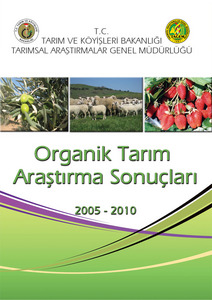VAROL, Nurhan; ALPER, Naciye; KÖSEOĞLU, Oya; TOPUZ, Halil; ÖZALTAŞ, Murat; PEKCAN, Tülin; TURAN, Sevim; GÜMÜŞAY, Bülent; ERTEN, Latife; ÖZTÜRK, Fatma; IRMAK, Şahnur; ATAOL ÖLMEZ, Handan and AKDOĞAN, Gülsüm (2011) Ege Bölgesinde Organik Zeytin Yetiştiriciliği. [Organic Olive Cultivation In The Aegean Region.] In: ALAY VURAL, Ayşen (Ed.) Organik Tarım Araştırma Sonuçları. T.C. Tarım ve Köyişleri Bakanlığı, Tarımsal Araştırmalar Genel Müdürlüğü, Ankara/Turkey, pp. 73-80.
![[thumbnail of Organik_tarim_kapak.jpg]](/19273/1.hassmallThumbnailVersion/Organik_tarim_kapak.jpg)  Preview |
Image (JPEG)
- Published Version
- Turkish/Türkiye
174kB |
|
PDF
- Published Version
- Turkish/Türkiye
372kB |
Document available online at: http://www.tagem.gov.tr
Summary in the original language of the document
Bu çalışmada, insan beslenmesi ve sağlığı açısından çok önemli bir ürün olan zeytinin yetiştirilmesinde, konvansiyonel yöntemlere alternatif olarak organik tarım yöntemlerinin uygulanabilirliğinin belirlenmesi, fenolojik, pomolojik ve ekonomik farklılıkların ortaya konması amaçlanmıştır. Çalışma Güney Ege Bölgesinin en önemli yağlık çeşidi olan Memecik zeytin çeşidinde Zeytincilik Araştırma Enstitüsünün Kemalpaşa üretim alanında 2004-2007 yılları arasında yürütülmüştür. Çalışmada organik parsellerde toprak verimliliğini artırmak amacıyla yeşil gübreleme, organik gübre, organik tarım yönetmeliğinde izin verilen mineral maddeler, konvansiyonel parsellerde ise kimyasal gübreler uygulanmıştır. Zeytin sineği popülasyon takibi Mc phail ve sarı yapışkan tuzaklar, zeytin güvesi ise delta tipi feremon tuzaklar ile yapılmıştır. Organik parsellerde zeytin sineği mücadelesinde Ecotrap, neemazal ve kaolin uygulamaları yapılmıştır. Konvansiyonel parsellerde mücadele Fenthion ile yapılmıştır. Her iki parseldeki ağaçlarda sürgün boyu, somak ve çiçek adeti, meyvelerde ise tane adedi ve ağırlığı, eni, boyu, et/çekirdek oranları, ürün miktarları tespit edilmiştir. Elde edilen zeytinyağlarında ise yağ asitleri bileşimleri ve zeytinyağı kalite parametreleri değerlendirilmiştir. Ayrıca yaprak ve toprak analizleri ile bitki besin maddelerinin değişimleri incelenmiş, parsellerden elde edilen meyvelerde kalıntı analizleri yapılmıştır. Meyve örneklerinde yapılan analizlerde organik fosforlu nitrojenli ve sülfürlü pestisitlere rastlanmamıştır. Her iki grupta da ürün miktarı, yağ kalite parametreleri ve yağ asitleri bileşiminde önemli bir farklılık bulunmamıştır. Yapılan organik tarım uygulamalarıyla, konvansiyonel yöntemler uygulanarak sağlanan verim ve kalitede ürün elde edilmiştir.
Summary translation
It was intended in this study to find out the practicability of the organic agricultural methods as an alternative for conventional methods and to reveal phenological, phomological and economical differences in cultivation of olive, which is a very important product for human nutrition and health. This study was carried out at the Kemalpaşa production field of the Olive Research Institute between the years of 2004 and 2007 using Memecik variety, which is the most important variety of olive oil in the Southern Aegean Region. During the study, green manuring, organic fertilizer, mineral substances that are allowed by the organic agriculture regulation were applied to raise the soil productivity in the organic blocks and chemical fertilizers were applied in the conventional blocks. Monitoring of olive fruit fly population was carried out by Mc phail and yellow sticky traps, and that of olive moth was carried out by delta type pheromone traps. In organic blocks, Ecotrap, neemazal and kaolin applications were conducted to fight against olive fruit fly. This fight was realized by Fenthion in conventional blocks. For the trees of either block, shoot length and inflorescence and flower quantities in numbers were determined, and, for the fruits, quantities in numbers and their individual weights, widths, lengths, flesh/stone ratios and product quantities were determined. Besides, for the derived olive oils, oil acid compositions and quality parameters of olive oil were assessed.
Moreover, the variations in the plant nutritional substances were traced through leaf and soil analyses, and also, residue analyses were conducted on the fruits that were obtained from these lots. No organic phosphorus, nitrogenous or sulfuric pesticides were discovered in the analyses that were conducted by using fruit samples. No any important differences were found between these two groups with regards to product quantity, oil quality parameters and oil acid composition. Through these organic agricultural practices, products that were similar in productivity and quality with those obtained through application of conventional methods were obtained.
| EPrint Type: | Book chapter |
|---|---|
| Keywords: | Zeytin, Zetyin yağı, organik tarım, Memecik, Ege Bölgesi, Olive, olive oil, organic farming, Memecik, Aegean region |
| Research affiliation: | Turkey > Olive Research Institute |
| Related Links: | http://www.zae.gov.tr |
| Deposited By: | VURAL, Dr. Aysen ALAY |
| ID Code: | 19273 |
| Deposited On: | 09 Aug 2011 13:39 |
| Last Modified: | 11 Aug 2011 10:22 |
| Document Language: | Turkish/Türkiye |
| Status: | Published |
| Refereed: | Not peer-reviewed |
Repository Staff Only: item control page

 Download Statistics
Download Statistics Download Statistics
Download Statistics
